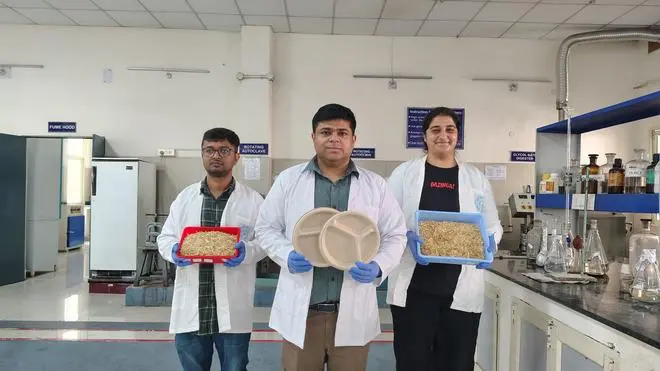




*Researchers involved in IIT Roorkee’s wheat straw project that claims to address stubble burning and air pollution. Picture courtesy thehindubussinessline.com
If the innovative technology can convert wheat straw into tableware is usable, it can help contain I
a severe menace caused by an old agriculture practice- stubble burning.
In fact, stubble burning is a post-harvest agricultural practice of farmers, particularly in regions like Punjab and Haryana in India.
It has been posing a major threat through severe air pollution, soil degradation, and negative health impacts in heart and lungs of people in several parts of the country, especially New Delhi.
Against this backdrop, IIT Roorkee has come up with an innovative research finding that can convert wheat straw into tableware. Really?
Yes, researchers at the INNOPAP Lab (Innovations in Paper and Packaging) at the IIT Roorkee, in collaboration with Aurangabad-based Parason Machinery India Pvt. Ltd., have developed a process that creatively utilises wheat stubble or straw, a common agricultural residue often burned after harvest, to produce eco-friendly tableware.
Notably, every post-wheat and paddy harvest season, the country produces more than 350 million tonnes of agricultural waste. A large proportion of this is either burned, worsening air quality and contributing to climate change, or left to decay.
“By innovatively utilising wheat straw, this research not only mitigates environmental harm but also provides farmers with an additional source of income, fostering a circular economy model that converts waste into wealth,” Vibhore K. Rastogi, a Professor at the institute’s Department of Paper Technology that led the project, is on record having said.
The technology is to produce creative products from wheat straw, which can also replace single-use plastic by creating products that decompose within the soil itself. This product utilises wheat straw because it contains a high cellulose content, about 40 to 50 per cent, which is essential for achieving the required good strength in the resulting tableware.
While cellulose is primarily responsible for the strength, the hemicellulose and lignin components are necessary to bond the cellulose fibers together.
One kilogram of straw gives about 400 to 450 grams of pulp, ensuring good supply of raw material to produce the products in the bulk.
The range of products that can be created using this pulp molding technology is broad, extending beyond single-use plates and cups to include various tablewares (two-, three-, or five-compartment plates), and general packaging material.
“We are currently working on producing a cushioning material to replace the regular packaging material used in packing electronics,” Rastogi said.
“Durable, heat-resistant and food-safe, these products embody the philosophy of Mitti se Mitti Tak originating from the earth, serving people and returning to the soil without causing harm,” he said.
“This research shows how everyday crop residues can be transformed into high-quality, eco-friendly products. It demonstrates the potential of science and engineering to deliver solutions that are both environmentally sound and economically viable,” he added.
Jasmine Kaur (PhD student) and Rahul Ranjan (postdoctoral researcher) made significant contributions to the development of molded tableware.



